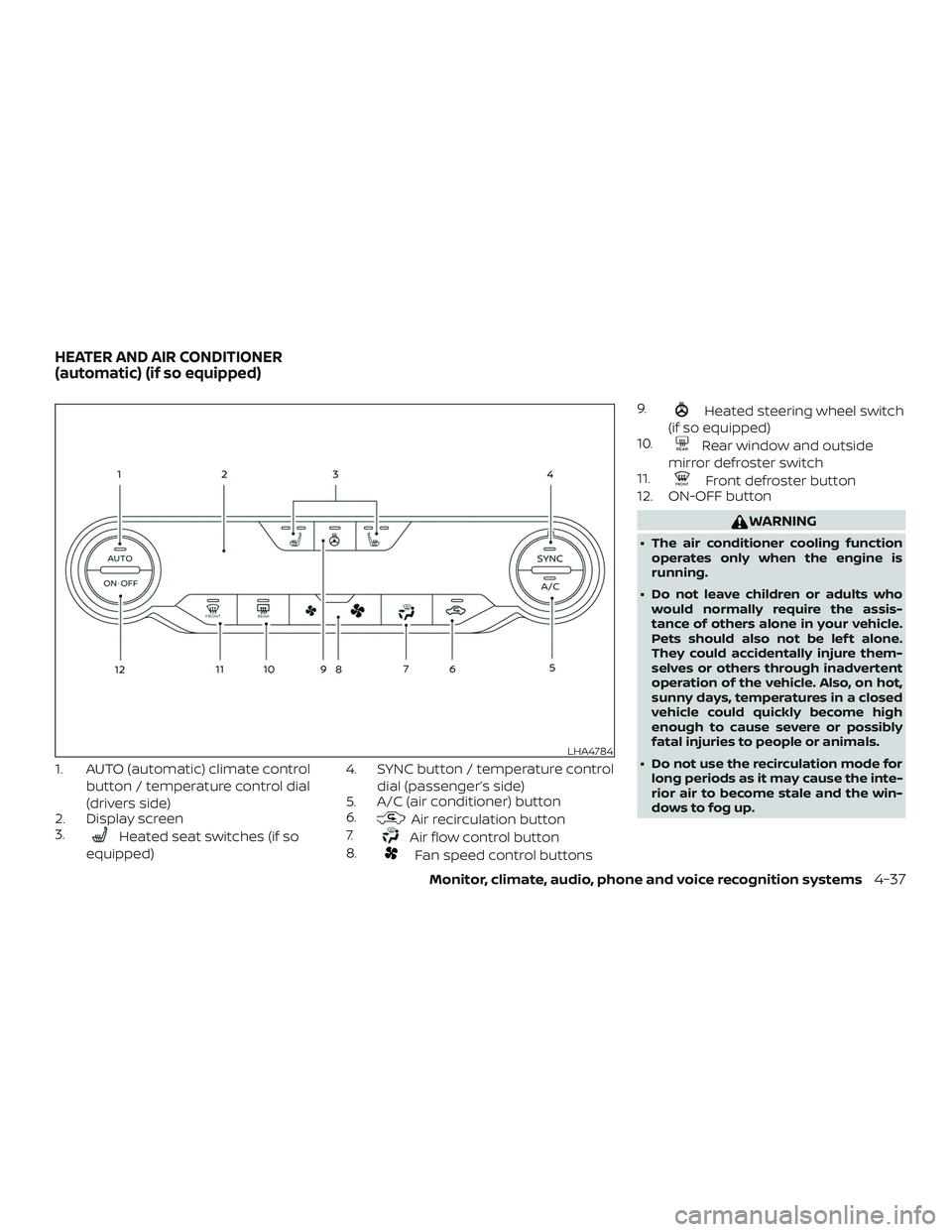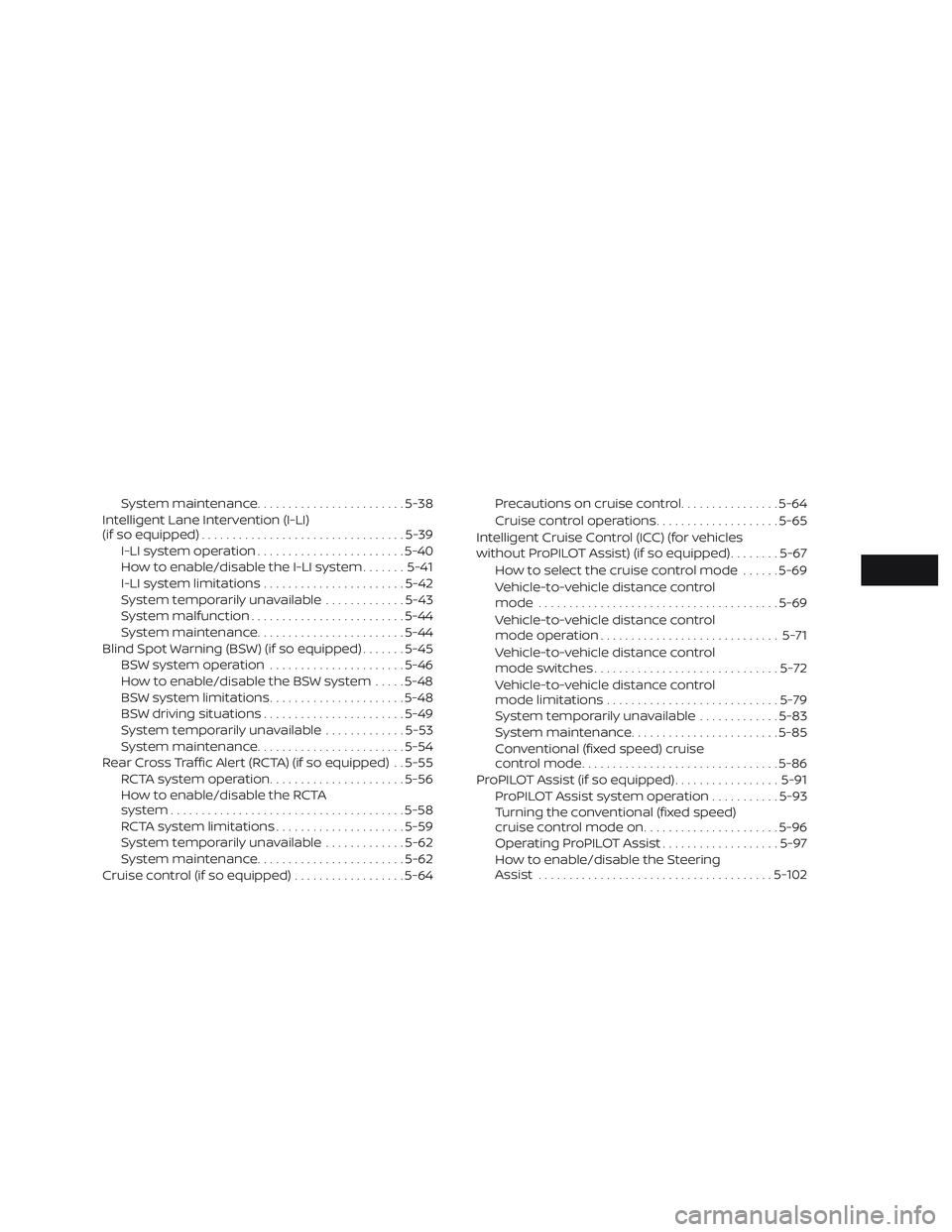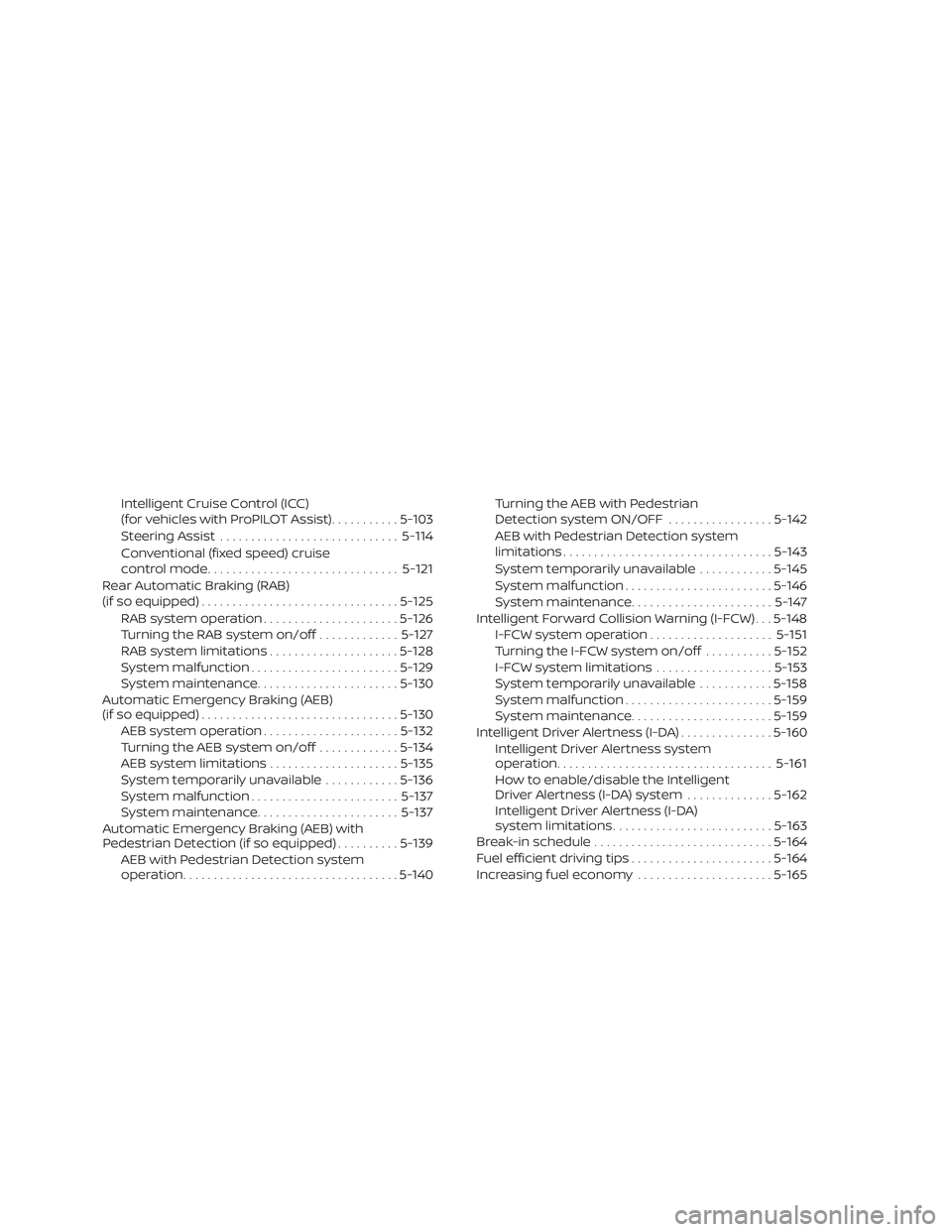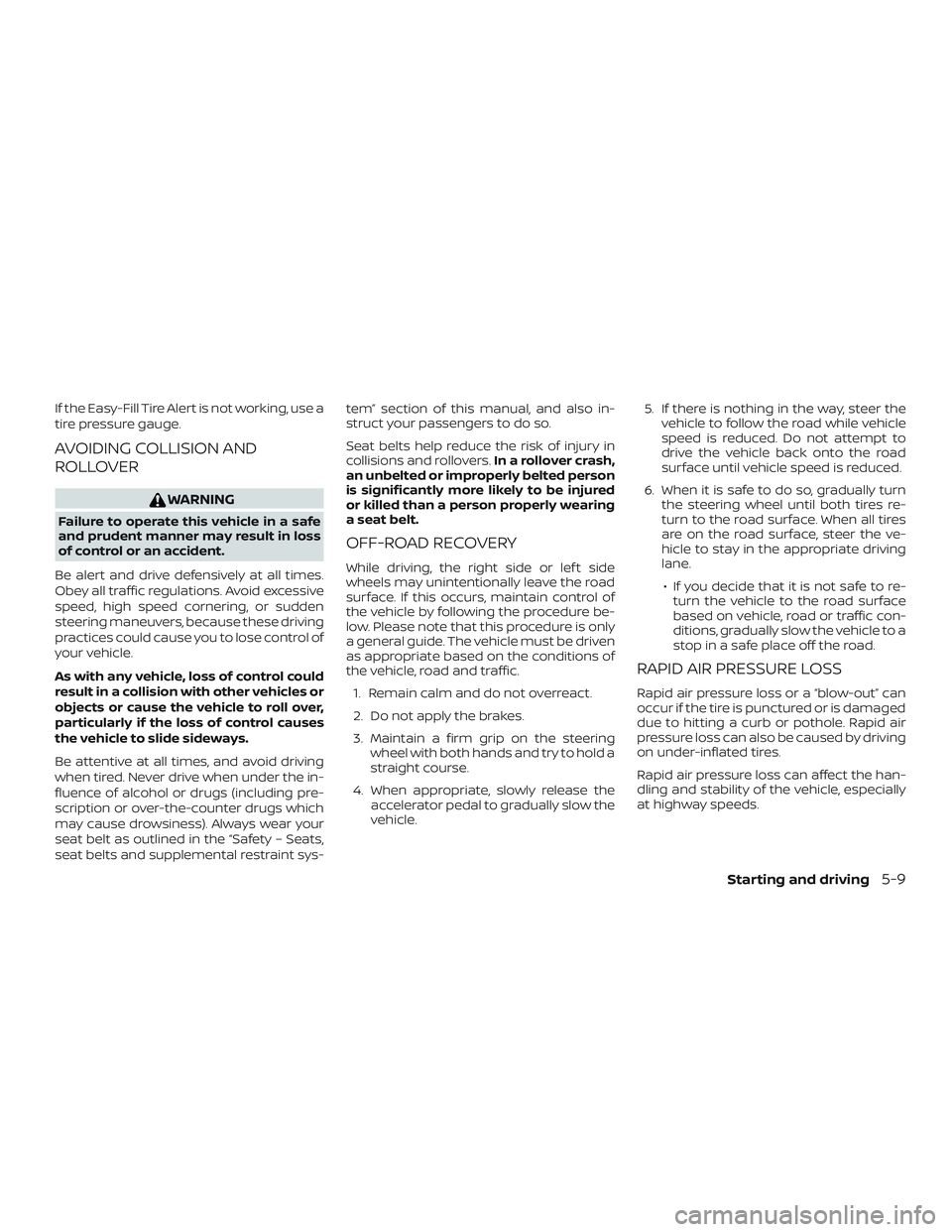2019 NISSAN ALTIMA steering
[x] Cancel search: steeringPage 251 of 592

1. AUTO (automatic) climate controlbutton / temperature control dial
(drivers side)
2. Display screen
3.
Heated seat switches (if so
equipped) 4. SYNC button / temperature control
dial (passenger’s side)
5. A/C (air conditioner) button
6.
Air recirculation button
7.
Air flow control button
8.
Fan speed control buttons 9.
Heated steering wheel switch
(if so equipped)
10.
Rear window and outside
mirror defroster switch
11.
Front defroster button
12. ON-OFF button
WARNING
∙ The air conditioner cooling function
operates only when the engine is
running.
∙ Do not leave children or adults who would normally require the assis-
tance of others alone in your vehicle.
Pets should also not be lef t alone.
They could accidentally injure them-
selves or others through inadvertent
operation of the vehicle. Also, on hot,
sunny days, temperatures in a closed
vehicle could quickly become high
enough to cause severe or possibly
fatal injuries to people or animals.
∙ Do not use the recirculation mode for long periods as it may cause the inte-
rior air to become stale and the win-
dows to fog up.
LHA4784
HEATER AND AIR CONDITIONER
(automatic) (if so equipped)
Monitor, climate, audio, phone and voice recognition systems4-37
Page 253 of 592

Remote Engine Start with
Intelligent Climate Control (if so
equipped)
Vehicles equipped with automatic climate
controls and Remote Engine Start function
may go into automatic heating or cooling
mode when Remote Engine Start is acti-
vated depending on outside and cabin
temperatures. During this period, the cli-
mate control display and buttons will be
inoperable until the ignition switch is
turned on. In Remote Engine Start defrost-
ing mode, the rear window defroster and
heated steering wheel (if so equipped) may
be activated automatically.
MANUAL OPERATION
Fan speed control buttons
Press thefan speed control buttons
to manually control the fan speed.
Press the AUTO button to return to auto-
matic control of the fan speed.
Temperature control dial
The temperature control dial allows you to
adjust the temperature of the outlet air. To
lower the temperature, turn the dial to the
lef t. To increase the temperature, turn the dial to the right. Temperature can be ad-
justed on the driver’s and passenger’s side.
Air recirculation
Press theair recirculation button to
recirculate interior air inside the vehicle.
The
indicator light on the button will
come on.
The air recirculation cannot be activated
when the air conditioner is in the
front defrosting mode.
When the outside temperature exceeds
70°F (21°C), the air conditioning system may
default to air recirculation mode automati-
cally to reduce overall power consumption.
To exit air recirculation mode, deselect the
air recirculation button (indicator light will
turn off ) to enter fresh air mode.
Automatic intake air control
In the AUTO mode, the intake air will be
controlled automatically. To manually con-
trol the intake air, press the
air recir-
culation button. To return to the automatic
control mode, press and hold the
air
recirculation button for about 2 seconds.
The indicator light will flash twice, and then
the intake air will be controlled automati-
cally.
A/C (air conditioner) button
Start the engine, press thefan speed
control buttons to the desired position and
press the
button to turn on the air
conditioner. To turn off the air conditioner,
press the
button again.
The air conditioner cooling function op-
erates only when the engine is running.
Air flow control
Pressing thebutton manually con-
trols air flow and selects the air outlet:
— Air flows from center and side
vents.
— Air flows from center and sidevents and foot outlets.
— Air flows mainly from footoutlets.
— Air flows from defroster andfoot outlets.
Synchronize climate settings
Press the SYNC button to synchronize cli-
mate settings. The sync indicator will turn
on.
Pressing SYNC will synchronize driver’s and
front passenger’s climate settings.
Monitor, climate, audio, phone and voice recognition systems4-39
Page 254 of 592

To change climate settings when SYNC is
active (the SYNC indicator is on):∙ The driver’s side temperature control dial will control the driver and front pas-
senger temperatures.
∙ The fan speed control dial will control the fan speeds.
To exit SYNC:
∙ To remove the front passenger from SYNC, turn the passenger’s side tem-
perature control dial.
∙ Pressing SYNC multiple times will re- activate SYNC.
To turn system off
Press the ON-OFF button.
Rear window and outside mirror
defroster switch
For additional information, refer to “Rear
window and outside mirror (if so equipped)
defroster switch” in the “Instruments and
controls” section of this manual.
Heated seat switches (if so
equipped)
For additional information, refer to “Heated
seat switches” in the “Instruments and con-
trols” section of this manual.
Heated steering wheel switch
(if so equipped)
For additional information, refer to “Heated
steering wheel switch” in the “Instruments
and controls” section of this manual.
OPERATING TIPS
The sunload sensor, located on the top
center of the instrument panel, helps the
system maintain a constant temperature.
Do not put anything on or around this sen-
sor.
LHA4943
4-40Monitor, climate, audio, phone and voice recognition systems
Page 259 of 592

System maintenance........................ 5-38
Intelligent Lane Intervention (I-LI)
(if so equipped) ................................. 5-39
I-LI system operation ........................ 5-40
How to enable/disable the I-LI system .......5-41
I-LI system limitations .......................5-42
System temporarily unavailable .............5-43
System malfunction ......................... 5-44
System maintenance ........................ 5-44
Blind Spot Warning (BSW) (if so equipped) .......5-45
BSW system operation ......................5-46
How to enable/disable the BSW system .....5-48
BSW system limitations ......................5-48
BSW driving situations .......................5-49
System temporarily unavailable .............5-53
System maintenance ........................ 5-54
Rear Cross Traffic Alert (RCTA) (if so equipped) . . 5-55 RCTA system operation ......................5-56
How to enable/disable the RCTA
system ...................................... 5-58
RCTA system limitations .....................5-59
System temporarily unavailable .............5-62
System maintenance ........................ 5-62
Cruise control (if so equipped) ..................5-64Precautions on cruise control
................5-64
Cruise control operations ....................5-65
Intelligent Cruise Control (ICC) (for vehicles
without ProPILOT Assist) (if so equipped) ........5-67
How to select the cruise control mode ......5-69
Vehicle-to-vehicle distance control
mode ....................................... 5-69
Vehicle-to-vehicle distance control
mode operation ............................. 5-71
Vehicle-to-vehicle distance control
mode switches .............................. 5-72
Vehicle-to-vehicle distance control
mode limitations ............................ 5-79
System temporarily unavailable .............5-83
System maintenance ........................ 5-85
Conventional (fixed speed) cruise
c
ontrol mode ................................ 5-86
ProPILOT Assist (if so equipped) .................5-91
ProPILOT Assist system operation ...........5-93
Turning the conventional (fixed speed)
cruise control mode on ......................5-96
Operating ProPILOT Assist ...................5-97
How to enable/disable the Steering
Assist ...................................... 5-102
Page 260 of 592

Intelligent Cruise Control (ICC)
(for vehicles with ProPILOT Assist)...........5-103
Steering Assist ............................. 5-114
Conventional (fixed speed) cruise
control mode ............................... 5-121
Rear Automatic Braking (RAB)
(if so equipped) ................................ 5-125
RAB system operation ......................5-126
Turning the RAB system on/off .............5-127
RAB system limitations .....................5-128
System malfunction ........................ 5-129
System maintenance ....................... 5-130
Automatic Emergency Braking (AEB)
(if so equipped) ................................ 5-130
AEB system operation ......................5-132
Turning the AEB system on/off .............5-134
AEB system limitations .....................5-135
System temporarily unavailable ............5-136
System malfunction ........................ 5-137
System maintenance ....................... 5-137
Automatic Emergency Braking (AEB) with
Pedestrian Detection (if so equipped) ..........5-139
AEB with Pedestrian Detection system
operation ................................... 5-140Turning the AEB with Pedestrian
Detection system ON/OFF
.................5-142
AEB with Pedestrian Detection system
limitations .................................. 5-143
System temporarily unavailable ............5-145
System malfunction ........................ 5-146
System maintenance ....................... 5-147
Intelligent Forward Collision Warning (I-FCW) . . . 5-148 I-FCW system operation ....................5-151
Turning the I-FCW system on/off ...........5-152
I-FCW system limitations ...................5-153
System temporarily unavailable ............5-158
System malfunction ........................ 5-159
System maintenance ....................... 5-159
Intelligent Driver Alertness (I-DA) ...............5-160
Intelligent Driver Alertness system
operation ................................... 5-161
How
to enable/disable the Intelligent
Driver Alertness (I-DA) system ..............5-162
Intelligent Driver Alertness (I-DA)
system limitations .......................... 5-163
Break-in schedule ............................. 5-164
Fuel efficient driving tips .......................5-164
Increasing fuel economy ......................5-165
Page 261 of 592

All-Wheel Drive (AWD) (if so equipped)..........5-166
Parking/parking on hills .......................5-168
Power steering ................................ 5-169
Brake system .................................. 5-170
Brake precautions .......................... 5-170
Anti-lock Braking System (ABS) ..............5-171
Brake Assist ................................ 5-172
Vehicle Dynamic Control (VDC) system ........5-172
Brake force distribution .....................5-174
Chassis Control ............................... 5-175
Intelligent Trace Control (I-TC) ...............5-175
Active Ride Control (ARC) ...................5-175
Hill start assist system ......................... 5-176
Rear Sonar System (RSS) (if so equipped) ......5-176
System operation .......................... 5-177
How to enable/disable the sonar
system ..................................... 5-179Sonar limitations
........................... 5-180
System temporarily unavailable ............5-180
System maintenance ....................... 5-181
Cold weather driving .......................... 5-181
Freeing a frozen door lock ..................5-181
Antifreeze .................................. 5-181
Battery..................................... 5-181
Draining of coolant water ...................5-182
Tire equipment ............................. 5-182
Special winter equipment ..................5-182
Driving on snow or ice ......................5-182
Engine block heater (if so equipped) ........5-183
Active noise cancellation/Active sound
enhancement (if so equipped) .................5-184
Active noise cancellation ...................5-184
Active sound enhancement ................5-184
Page 265 of 592

∙ If the low tire pressure warning lightilluminates while driving, avoid sud-
den steering maneuvers or abrupt
braking, reduce vehicle speed, pull off
the road to a safe location and stop
the vehicle as soon as possible. Driv-
ing with underinflated tires may per-
manently damage the tires and in-
crease the likelihood of tire failure.
Serious vehicle damage could occur
and may lead to an accident and could
result in serious personal injury.
Check the tire pressure for all four
tires. Adjust the tire pressure to the
recommended COLD tire pressure
shown on the Tire and Loading Infor-
mation label to turn the low tire pres-
sure warning light off. If you have a flat
tire, replace it with a spare tire as soon
as possible. (For additional informa-
tion, refer to “Flat tire” in the “In case of
emergency ” section for changing a
flat tire.) ∙ When replacing a wheel without the
TPMS such as the spare tire, when a
spare tire is mounted or a wheel is
replaced, tire pressure will not be indi-
cated, the TPMS will not function and
the low tire pressure warning light will
flash for approximately 1 minute. The
light will remain on af ter 1 minute. It is
recommended that you visit a NISSAN
dealer for tire replacement and/or
system resetting.
∙ Replacing tires with those not origi- nally specified by NISSAN could affect
the proper operation of the TPMS.
∙ Do not inject any tire liquid or aerosol tire sealant into the tires, as this may
cause a malfunction of the tire pres-
sure sensors.
CAUTION
Do not place metalized film or any
metal parts (antenna, etc.) on the win-
dows. This may cause poor reception of
the signals from the tire pressure sen-
sors, and the TPMS will not function
properly. Some devices and transmitters may tem-
porarily interfere with the operation of the
TPMS and cause the low tire pressure
warning light to illuminate.
Some examples are:
∙ Facilities or electric devices using simi- lar radio frequencies are near the ve-
hicle.
∙ If a transmitter set to similar frequen- cies is being used in or near the vehicle.
∙ If a computer (or similar equipment) or a DC/AC converter is being used in or
near the vehicle.
The low tire pressure warning light may
illuminate in the following cases: ∙ If the vehicle is equipped with a wheel and tire without TPMS.
∙ If the TPMS has been replaced and the ID has not been registered.
∙ If the wheel is not originally specified by NISSAN.
Starting and driving5-7
Page 267 of 592

If the Easy-Fill Tire Alert is not working, use a
tire pressure gauge.
AVOIDING COLLISION AND
ROLLOVER
WARNING
Failure to operate this vehicle in a safe
and prudent manner may result in loss
of control or an accident.
Be alert and drive defensively at all times.
Obey all traffic regulations. Avoid excessive
speed, high speed cornering, or sudden
steering maneuvers, because these driving
practices could cause you to lose control of
your vehicle.
As with any vehicle, loss of control could
result in a collision with other vehicles or
objects or cause the vehicle to roll over,
particularly if the loss of control causes
the vehicle to slide sideways.
Be attentive at all times, and avoid driving
when tired. Never drive when under the in-
fluence of alcohol or drugs (including pre-
scription or over-the-counter drugs which
may cause drowsiness). Always wear your
seat belt as outlined in the “Safety – Seats,
seat belts and supplemental restraint sys- tem” section of this manual, and also in-
struct your passengers to do so.
Seat belts help reduce the risk of injury in
collisions and rollovers.
In a rollover crash,
an unbelted or improperly belted person
is significantly more likely to be injured
or killed than a person properly wearing
a seat belt.
OFF-ROAD RECOVERY
While driving, the right side or lef t side
wheels may unintentionally leave the road
surface. If this occurs, maintain control of
the vehicle by following the procedure be-
low. Please note that this procedure is only
a general guide. The vehicle must be driven
as appropriate based on the conditions of
the vehicle, road and traffic.
1. Remain calm and do not overreact.
2. Do not apply the brakes.
3. Maintain a firm grip on the steering wheel with both hands and try to hold a
straight course.
4. When appropriate, slowly release the accelerator pedal to gradually slow the
vehicle. 5. If there is nothing in the way, steer the
vehicle to follow the road while vehicle
speed is reduced. Do not attempt to
drive the vehicle back onto the road
surface until vehicle speed is reduced.
6. When it is safe to do so, gradually turn the steering wheel until both tires re-
turn to the road surface. When all tires
are on the road surface, steer the ve-
hicle to stay in the appropriate driving
lane.
∙ If you decide that it is not safe to re- turn the vehicle to the road surface
based on vehicle, road or traffic con-
ditions, gradually slow the vehicle to a
stop in a safe place off the road.
RAPID AIR PRESSURE LOSS
Rapid air pressure loss or a “blow-out” can
occur if the tire is punctured or is damaged
due to hitting a curb or pothole. Rapid air
pressure loss can also be caused by driving
on under-inflated tires.
Rapid air pressure loss can affect the han-
dling and stability of the vehicle, especially
at highway speeds.
Starting and driving5-9